Catching Up with National Joint Committee for the Communication Needs of Persons with Severe Disabilities
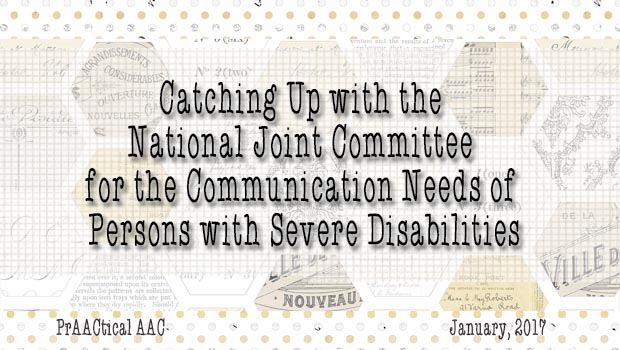
The NJC has been one of my go-to resources for many years, so I was delighted when Amy Goldman agreed to write an update on recent activities. Amy is one of my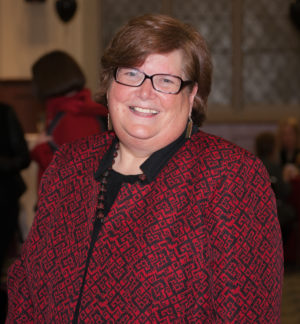 AAC heroes but you may know her best from her long career of advocacy with AAC and AT through professional organizations (e.g., ASHA, USSAAC, ATIA, PSHA, ATAP). Amy is now one of three technical assistance specialists with the national Assistive Technology Act Technical Assistance and Training Center (AT3). She recently retired from her position as Co-Executive Director of the Institute on Disabilities at Temple University, PA’s University Center of Excellence in Developmental Disabilities where she directed local, state, and federal projects related to assistive technology. She is honored to represent ASHA on the National Joint Committee for the Communication Needs of Persons with Severe Disabilities (NJC). She and I co-chair the ATIA strand on AAC and hope to see many of you at the 2017 ATIA Conference, specifically the AAC Strand Spotlight (Thursday 1/19 at 1:00 pm in the Caribbean 2 ballroom).
AAC heroes but you may know her best from her long career of advocacy with AAC and AT through professional organizations (e.g., ASHA, USSAAC, ATIA, PSHA, ATAP). Amy is now one of three technical assistance specialists with the national Assistive Technology Act Technical Assistance and Training Center (AT3). She recently retired from her position as Co-Executive Director of the Institute on Disabilities at Temple University, PA’s University Center of Excellence in Developmental Disabilities where she directed local, state, and federal projects related to assistive technology. She is honored to represent ASHA on the National Joint Committee for the Communication Needs of Persons with Severe Disabilities (NJC). She and I co-chair the ATIA strand on AAC and hope to see many of you at the 2017 ATIA Conference, specifically the AAC Strand Spotlight (Thursday 1/19 at 1:00 pm in the Caribbean 2 ballroom).
Many thanks to Amy for sharing this wonderful overview of the NJC! If you are on Facebook, please support the NJC by visiting their page and sharing the resources posted there.
The National Joint Committee for the Communication Needs of Persons with Severe Disabilities (NJC) celebrated the 30th anniversary of its founding. It was established in 1986 by TASH (then The Association for Severe Handicaps) and the American Speech-Language-Hearing Association (ASHA) as an outgrowth of a Consensus Conference (1985) supported by the US Department of Education Office of Special Education Programs (OSEP) which had offered more than 30 recommendations regarding the communication needs of children with significant disabilities. The purpose of the NJC is to advocate for persons with significant communication support needs resulting from intellectual disability that may coexist with autism, sensory, and/or motor disabilities. NJC’s focus includes research, policy, practice, and training.
Since 1986, the NJC’s membership has grown to include representatives of the Council for Exceptional Children (CEC; Communication Disorders Division), the United States Society for Augmentative and Alternative Communication (USSAAC), the Association of Assistive Technology Act Programs (ATAP), the American Association on Intellectual and Developmental Disabilities (AAIDD) , the American Occupational Therapy Association (AOTA), the American Physical Therapy Association (APTA), and the Rehabilitation Engineering and Assistive Technology Society of North America (RESNA).
The interdisciplinary nature of the organization reflects the pervasive importance of communication in all spheres of human functioning and across traditional disciplinary boundaries. The NJC embodies a shared commitment to promoting effective communication by persons with severe disabilities, providing a common ground on which the disciplines represented by the member organizations can unite in their efforts to improve the quality of life of such persons.
In 1995, the NJC published its first “Communication Bill of Rights” (CBR) reflecting the principles of the NJC member organizations and affirming the rights of persons with severe disabilities to benefit from communication interventions and what those interventions should include. In 2015, the NJC revised the CBR, published in an article in the American Journal on Intellectual and Developmental Disabilities. The updated CBR (available in pdf format suitable for printing) reflects the ICF bio-social model, highlights the importance of communication partners and the context of communication, and recognizes the goal of communication skill-building is to promote inclusion in the community and across the lifespan.
Recognizing the importance of the ability to express a range of pragmatic functions, the NJC emphasizes functions beyond requesting things (e.g. requesting information) and the importance of authentic choice-making as key to self-determination. The CBR now includes the right to make comments and share opinions, and the right to be given information about people and events in one’s life. Importantly, the right to have access to functioning AAC (and other assistive technologies) at all times is addressed. The CBR can be an effective tool to explain to all communication partners their role in supporting communication and participation for people with severe disabilities, with a focus on meaningful contexts and routines and functional outcomes.
In 2016, the NJC established the NJC Network” to expand the number of professionals with a common interest in enhancing communication effectiveness for individuals with severe disabilities. Go to www.asha.org/njc to join and learn about networking opportunities to engage in research, promote the Communication Bill of Rights, and expand appropriate practices.
RESOURCES:
ASHA hosts the website for the NJC (click here). The site includes the revised Communication Bill of Rights, information about the McClean Yoder Award for Professional Excellence, and an application for interested persons to join the NJC Network.
Brady, N., Bruce, S., Goldman, A., Erickson, K., Mineo, B., Ogletree, B., . . . Wilkinson, K. (2016). Communication services and supports for individuals with severe disabilities: Guidance for assessment and intervention. American Journal on Intellectual and Developmental Disabilities, 121, 121-138.
Filed under: Featured Posts, PrAACtical Thinking
Tagged With: Communication Bill of Rights, NJC
This post was written by Carole Zangari


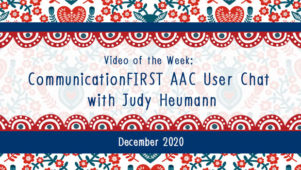
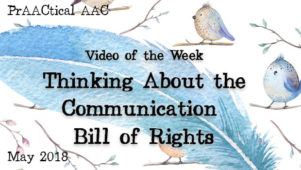
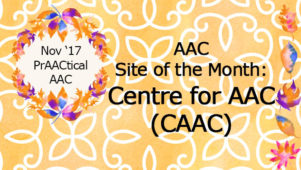
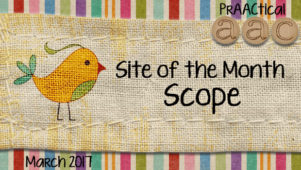
3 Comments
I was definitely going to this at ATIA until I saw that they put my presentation at the SAME time. 😑 😞
Oh no! Hope to see you at some point during the conference, Kathy!
Thank you for this post. It helps to see the big picture.